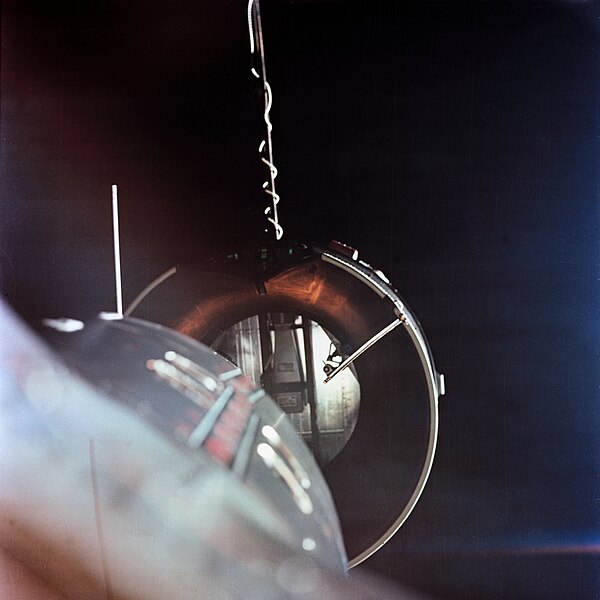Hello ladies and gents this is the Viking telling you that today we are talking about
 Gemini 8 (officially Gemini VIII) was the sixth crewed spaceflight in NASA's Gemini program, launched March 16, 1966. It was the twelfth crewed American flight and the twenty-second crewed spaceflight of all time [including two X-15 flights higher than the Kármán Line at 100 kilometers (54 nautical miles; 62 miles; 328,084 feet). The mission conducted the first docking of two spacecraft in orbit, but suffered the first critical in-space system failure of a U.S. spacecraft which threatened the lives of the astronauts and required an immediate abort of the mission. The crew was returned to Earth safely.
Gemini 8 (officially Gemini VIII) was the sixth crewed spaceflight in NASA's Gemini program, launched March 16, 1966. It was the twelfth crewed American flight and the twenty-second crewed spaceflight of all time [including two X-15 flights higher than the Kármán Line at 100 kilometers (54 nautical miles; 62 miles; 328,084 feet). The mission conducted the first docking of two spacecraft in orbit, but suffered the first critical in-space system failure of a U.S. spacecraft which threatened the lives of the astronauts and required an immediate abort of the mission. The crew was returned to Earth safely.
Command pilot Neil Armstrong's flight marked the second time a U.S. civilian flew into space (Joe Walker became the first on X-15 Flight 90, and the first time a U.S. civilian flew into orbit. Armstrong had resigned his commission in the United States Naval Reserve in 1960. The Soviet Union had launched the first civilian, Valentina Tereshkova (also the first woman), aboard Vostok 6 on June 16, 1963.
Gemini VIII was planned to be a three-day mission. After being launched into an 87-by-146-nautical-mile (161 by 270 km) orbit, on the fourth revolution it was to rendezvous and dock with an Agena target vehicle, which had been earlier launched into a 161-nautical-mile (298 km) circular orbit. This was to be the first space docking in history. Four separate dockings were planned.
During the first docking, Pilot David Scott planned to perform an ambitious, two-hour-and-10-minute extra-vehicular activity (EVA), which would have been the first since Ed White's June 1965 spacewalk on Gemini IV. On a 25-foot (7.6 m) tether for one and a half revolutions around the Earth, Scott would have retrieved a nuclear emulsion radiation experiment from the front of the Gemini's spacecraft adapter, then activate a micrometeoroid experiment on the Agena. Then he was to move back to the Gemini and test a minimum-reaction power tool by loosening and tightening bolts on a work panel.
During the EVA, after Armstrong undocked from the Agena, Scott was to don and test an Extravehicular Support Pack (ESP) stored at the back of the spacecraft adapter. This was a backpack with a self-contained oxygen supply, extra Freon propellant for his Hand Held Maneuvering Unit, and a 75-foot (23 m) extension to his tether. He would practice several maneuvers in formation with the Gemini and Agena vehicles (separated at distances up to 60 feet (18 m), in concert with Armstrong in the Gemini. Scott never got to perform this EVA, due to the abort of the flight because of an
emergency which occurred shortly after docking.
The flight also carried an additional three scientific, four technological, and one medical experiment. I hope you liked this post and as always have a chilled day from the Viking
GEMINI 8

Command pilot Neil Armstrong's flight marked the second time a U.S. civilian flew into space (Joe Walker became the first on X-15 Flight 90, and the first time a U.S. civilian flew into orbit. Armstrong had resigned his commission in the United States Naval Reserve in 1960. The Soviet Union had launched the first civilian, Valentina Tereshkova (also the first woman), aboard Vostok 6 on June 16, 1963.
Gemini VIII was planned to be a three-day mission. After being launched into an 87-by-146-nautical-mile (161 by 270 km) orbit, on the fourth revolution it was to rendezvous and dock with an Agena target vehicle, which had been earlier launched into a 161-nautical-mile (298 km) circular orbit. This was to be the first space docking in history. Four separate dockings were planned.
During the first docking, Pilot David Scott planned to perform an ambitious, two-hour-and-10-minute extra-vehicular activity (EVA), which would have been the first since Ed White's June 1965 spacewalk on Gemini IV. On a 25-foot (7.6 m) tether for one and a half revolutions around the Earth, Scott would have retrieved a nuclear emulsion radiation experiment from the front of the Gemini's spacecraft adapter, then activate a micrometeoroid experiment on the Agena. Then he was to move back to the Gemini and test a minimum-reaction power tool by loosening and tightening bolts on a work panel.
During the EVA, after Armstrong undocked from the Agena, Scott was to don and test an Extravehicular Support Pack (ESP) stored at the back of the spacecraft adapter. This was a backpack with a self-contained oxygen supply, extra Freon propellant for his Hand Held Maneuvering Unit, and a 75-foot (23 m) extension to his tether. He would practice several maneuvers in formation with the Gemini and Agena vehicles (separated at distances up to 60 feet (18 m), in concert with Armstrong in the Gemini. Scott never got to perform this EVA, due to the abort of the flight because of an
emergency which occurred shortly after docking.
The flight also carried an additional three scientific, four technological, and one medical experiment. I hope you liked this post and as always have a chilled day from the Viking
Comments
Post a Comment